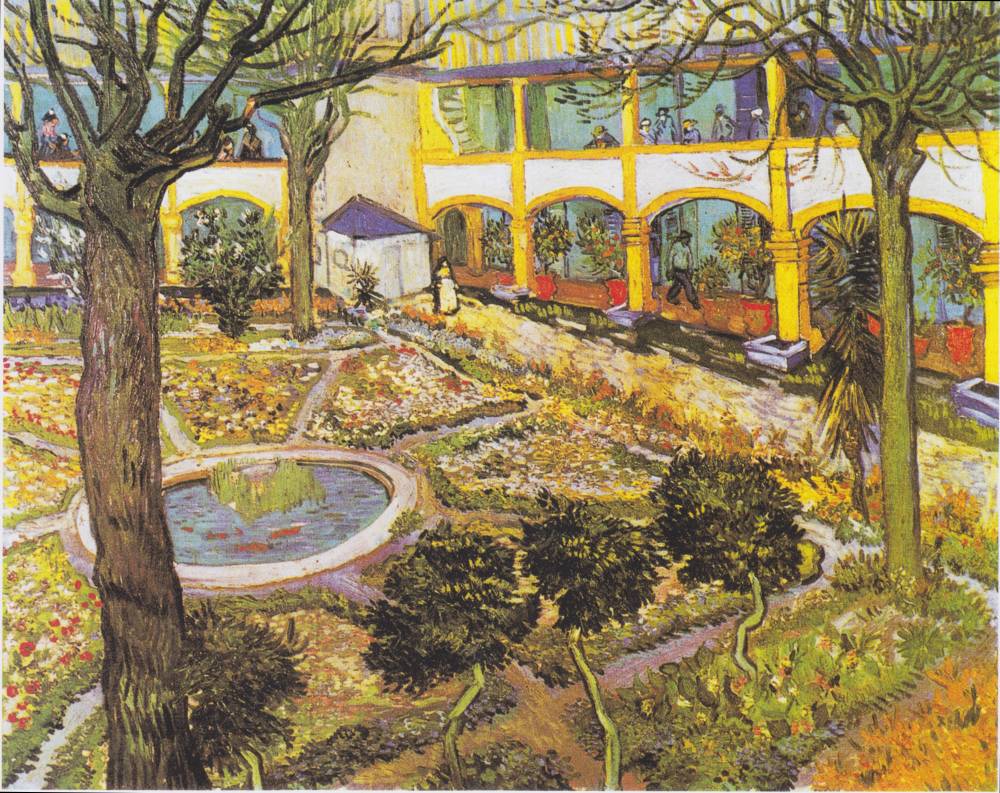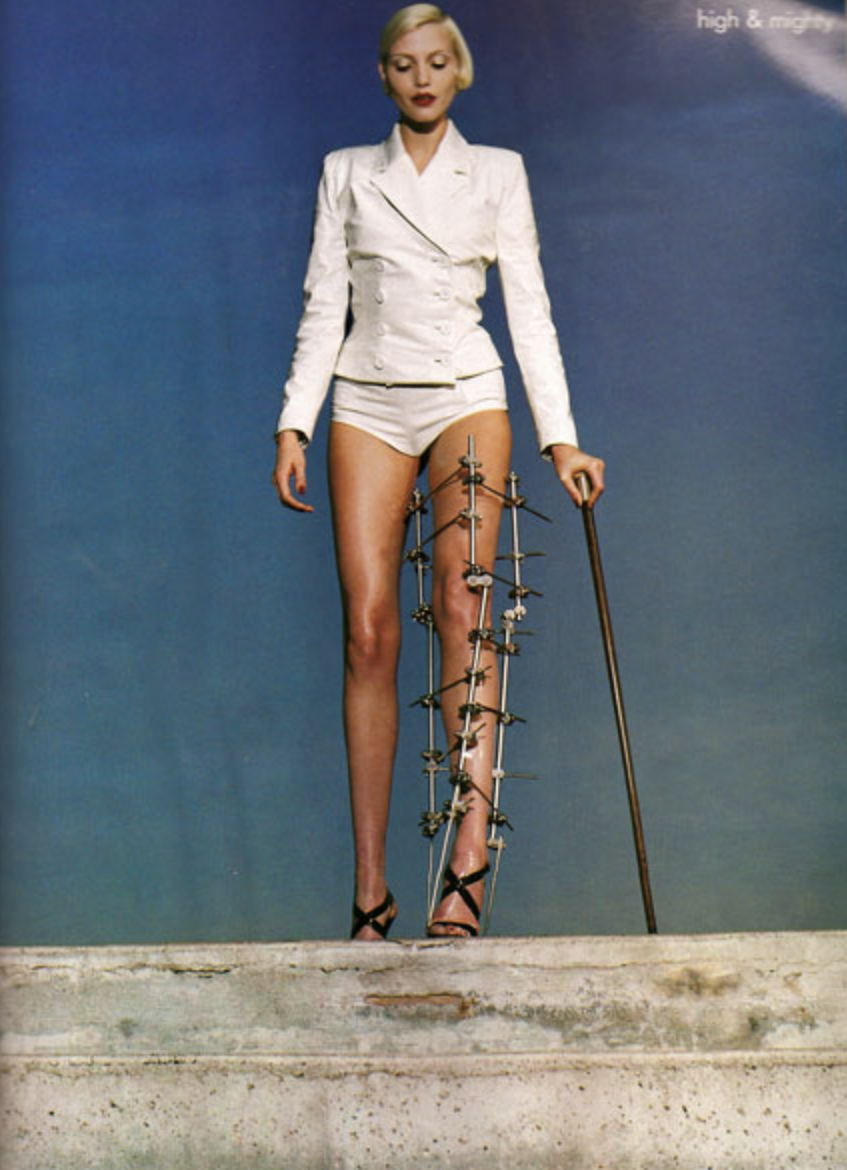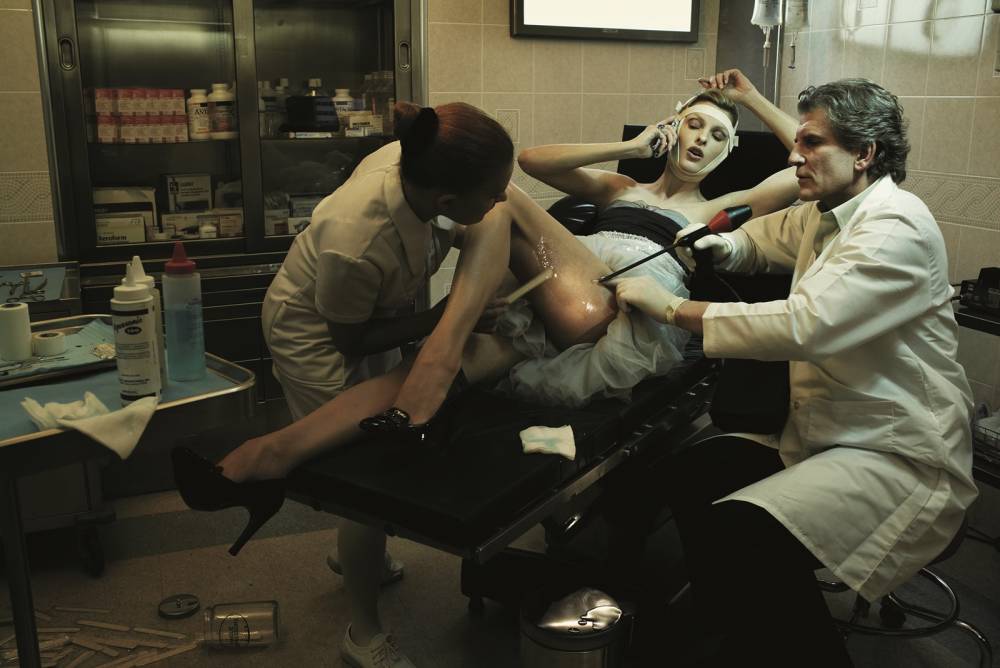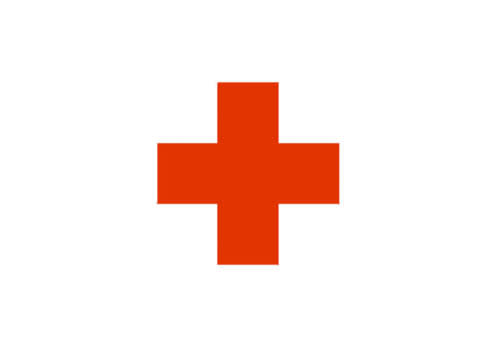
David LaChapelle
Free Consultation (Surgery Story), 1997
Looking back to the ancient civilizations of Greece and Rome, art and medicine have always been closely intertwined. A major anchor to this connection is the human body. Classical art looked to the human form as the source of inspiration for the highest form of design. Consider the Kritios Boy, a nude sculpture from Classical Greece. In combining the studies of art and medicine through the observation of the human form, artists were able to render movement in statues through a pose known as contrapposto, in which one leg is bent and the hips and shoulders misalign, creating a relaxed posture that heavily contrasts with the rigid poses of the past.
The usefulness of anatomical drawings in the creation of such statues cannot be understated, nor should their equal importance in science. Their documentation offers insight into both the medical practices and the idealized body standards of the times in which they were made. Leonardo da Vinci’s famous drawing “The Vitruvian Man,” made around 1487, is considered one of the premier achievements of Renaissance science. The drawing and accompanying notes map the “perfect” proportions of the human body according to the Roman architect Vitruvius.
The mapping of the human body’s proportions is significant to both art and science. It lays out clear standards for depictions of the human form in art, as well as having led to significant scientific discoveries. By studying the structure of the body, da Vinci was able to discover and map the core mechanical activity in the body’s skeletal and muscular systems. This led to further discoveries regarding the internal organs, and a subsequent set of drawings that combined the scientific with abstract representations of transparent layers, providing insight into the internal workings of the human body.
Leonardo da Vinci
Vitruvian Man, 1490
Leonardo da Vinci
Anatomical Sketch
Leonardo da Vinci
Anatomical Sketch
Like many artists, Jean-Michel Basquiat shared in da Vinci’s fascination with the human form and the medical field. The artist’s sketchbook depictions of the body with medical textbook labels show obvious interest in da Vinci’s studies before him, as well as inspiration from his childhood injury. While healing after being hit by a car, Basquiat read a medical textbook that his mother had given to him. The contrast of Basquiat’s abstract style with scientific labeling is both whimsical and fascinating.
The art world’s documentation of medicine is probably one of our biggest resources for insight into the medical practices and beliefs of the past, as suggested by the repeated depiction of the Saints Cosmas and Damian, twin brothers who practiced medicine for free and were said to cure blindness. Depictions honoring the brothers can be found in illuminated manuscripts from the 1500s, in which the pair clutch ointment jars and surgical instruments, or other examples which show the brothers performing a miracle leg transplant, inspired by the story of the saints coming to a devout man with a diseased leg in his sleep. The immortalization of these saints and their work is a great example of art’s continued ability to document the present for the education of future viewers.
Jean-Michel Basquiat
Untitled (Halloween), 1983
Jean-Michel Basquiat
Untitled (Anatomy), 1982
Jean Michel Basquiat
Early Moses, 1983
Saint Cosmas and Damian
Icon
A more contemporary example of medical practitioners in fine art is Richard Prince’s Nurse Paintings, made from 2002-2008. Inspired by the covers of inexpensive pulp romance novels, Prince scanned the original images and then personalized them with acrylic paint overlays. Throughout the series, the nurses depicted all wear white surgical masks, though sometimes their red lips bleed through. Prince’s work raises interesting questions about ownership in art, while also connecting to medicine, sexuality, literature and pop culture.
With the rapid development of the medical field, artists began looking to hospitals for inspiration. The contradiction of the sterile environment of a hospital with the grotesque procedures that take place in it proves to be a subject of immense fascination. Further still, artists with experience spending time in hospitals have used their art as an outlet for expressing the frustration and despair one feels when trapped inside such an environment. Vincent van Gogh painted his last months at an institution in Arles, resulting in “Ward of Arles Hospital,” in which the work’s warped corridor and blue tones express the artist’s feeling of isolation. In contrast, van Gogh’s paintings of the scenes outside of his window at the ward are filled with vibrant colors and movement. Norman Rockwell’s 1946 painting “The Waiting Room at the Hospital” depicts a similar anxiety, with nervous men pacing, smoking, and chewing their fingernails in anguish.
Similar to van Gogh, Frida Kahlo spent a period of her life confined to a hospital bed following a horrific bus accident in 1925, painting images of herself during her time in recovery. Kahlo originally had dreams to become a medical illustrator, and channeled her interest in medicine into her art, an interest that continued to impact her work through motifs depicting medical procedures and others centered around pressures on the female reproductive system.

Richard Prince
Nurse in Las Vegas, 2008

Richard Prince
Doctor's Nurse, 2002

Richard Prince
Dude Ranch Nurse #2, 2002-03

Richard Prince
Mission Nurse, 2002

Vincent van Gogh
Ward in the Hospital in Arles Hospital, 1889

Vincent van Gogh
Garten des Hospitals in Arles, 1889

Frida Kahlo
Henry Ford Hospital, 1932

Frida Kahlo
A Few Small Nips, 1935

Frida Kahlo
Left The Love Embrace of the Universe, 1949 - Right The Abortion, 1932
Gustav Klimt’s “Medicine,” one in a series of three murals, took an oppositional approach to the medical field, showing the mythical figure Hygeia, daughter of the god of medicine, with a snake on one arm, turning her back to mankind and representing the powerlessness of medical science. This was controversial at the time as Vienna was the world leader in medicine and was looking for a work to celebrate its triumphs.
Other artists have tried to brighten hospitals through their own work. With Keith Haring’s long history surrounding HIV/AIDS and sexual health activism, it is no surprise that in 1986 the artist would paint a 700-foot mural at Woodhull Hospital, injecting the sterile environment with his vivid, pop aesthetic.
Gustav Klimt
Medicine, 1907
Keith Haring
Mural at Woodhull Hospital, Brooklyn, 1986
As pop art emerged onto the scene, more artists began to focus on capitalism and consumption. Naturally, the melding of these concepts with medicine led many to consider the pharmaceutical industry. Perhaps because of their color and variation, medication and pills became a popular motif for many artists. Damien Hirst’s “Medicine Cabinet” series plays with ideas of healing through art, yet also raises questions surrounding conformism and consumerism, while his later work in the 2000s, a series of Pill paintings, plays with scale and color through enlarging these minuscule, everyday items. Hirst also used pharmaceutical labels as inspiration for a 1999 series titled “The Last Supper,” consisting of 13 screen-prints. The prints resemble pharmaceutical labels, but in place of medication names are the names of meals stemming from working class British culture such as “Steak and Kidney,” and “Cornish Pasty”. Again, the series speaks to the comparison of art and medicine as methods to heal. In 2000, American artist Tom Sachs took the theme of the medicine cabinet in yet another direction, creating a wall-mounted first aid kit like that one might find at a community center. With the cabinet open, viewers can see a mirror at the back and shelves chaotically stuffed with various medical supplies, held in by twine. An ominous stain around the Red Cross on the front and dripping red writing decidedly do not look to equate medicine to healing.
The king of pop art himself, Andy Warhol, evidently saw the possibilities in the conversation between art and medicine. In the years following his 1987 death in, the contents of Warhol’s own medicine cabinet became the subject of widespread fascination. Photographer David Gamble, who was commissioned to photograph Warhol’s New York townhouse, took shots of the inside of the artist’s medicine cabinet, and Warhol’s friend and former Interview employee Bob Colacello wrote down its contents. Warhol’s enduring legacy in pop art has survived, in part, due to this accidental work.
Damien Hirst
Sinner, 1988
Damien Hirst
Holidays, 1989
Damien Hirst
No Feelings, 1989
Damien Hirst
Cornish Pasty, 1999
Damien Hirst
Love Will Tear Us Apart, 1995
Tom Sachs
First Aid Kit, 2000
Tom Sachs
First Aid Kit, 2000
David Gamble
Andy Warhol's Medicine Cabinet, 1987
Much like art, the fashion world has taken an interest in medicine. This makes sense, as fashion cannot exist without the human body, and in fact regards and sculpts the ideal form much as they did in Ancient Greece.
Various fashion magazines have featured nurses, especially early 20th century wartime nurses, on their front covers. In recent years, photographers and art directors have turned to medicine as the subject of magazine editorials. Vogue’s “High and Mighty” spread from 1995, photographed by Helmut Newton, alludes to a sultry danger in wearing sky-high heels. The featured model is shown in various shots with a wheelchair, crutches, and a metal leg brace, all resembling David Cronenberg’s 1996 film Crash. Vogue Italia’s iconic 2005 editorial, “Makeover Madness” shot by Steven Meisel, depicts the prevalence of plastic surgery in modern day culture, showing models in glamorous gowns undergoing or recovering from procedures.
Meisel, in particular, has shot several stories that focus on different aspects of the medical field. His 2007 editorial for Vogue Italia, “Super Mods Enter Rehab,” depicts a clinical hospital setting that is softened by the camaraderie between patients, all famous supermodels, perhaps speaking to the pressure of the fashion industry on a individual’s wellbeing.

LOOK Magazine
October 20, 1942

American Vogue
Illustration by Porter Woodruff, 1940s

American Vogue
High and Mighty, photographed by Helmut Newton, 1995

American Vogue
High and Mighty, photographed by Helmut Newton, 1995

American Vogue
High and Mighty, photographed by Helmut Newton, 1995

Vogue Italia
Makeover Madness photographed by Steven Meisel, 2005

Vogue Italia
Makeover Madness photographed by Steven Meisel, 2005

Vogue Italia
Makeover Madness photographed by Steven Meisel, 2005

Vogue Italia
Makeover Madness photographed by Steven Meisel, 2005

Vogue Italia
Makeover Madness photographed by Steven Meisel, 2005

Vogue Italia
Makeover Madness photographed by Steven Meisel, 2005

Vogue Italia
Super Mods Enter Rehab photographed by Steven Meisel, 2007

Vogue Italia
Super Mods Enter Rehab photographed by Steven Meisel, 2007

Vogue Italia
Super Mods Enter Rehab photographed by Steven Meisel, 2007

Vogue Italia
Super Mods Enter Rehab photographed by Steven Meisel, 2007

Vogue Italia
Super Mods Enter Rehab photographed by Steven Meisel, 2007
Similarly, many designers have recreated hospitals, nurses, and asylums in their shows. In a 2008 collaboration with Richard Prince, orchestrated by then-creative director Marc Jacobs, Louis Vuitton debuted a collection in which models wore nurse uniforms and hats down the runway, brining to life Prince’s iconic paintings. Thom Browne’s Spring/Summer 2013 menswear collection set the stage with models tied to hospital beds, blindfolded and wearing crowns of thorns, loosely referencing a crucifixion. Most recently, Gucci’s Spring/Summer 2020 collection earned criticism for its straight-jacket opening looks, while the brand’s Fall/Winter 2018 runway show took place around a makeshift hospital set.
Others have more thoughtfully incorporated medicine into design, recreating doctor bags and ‘must have’ accessories. Prada’s Saffiano satchel and its variations reference the carryall’s iconic shape in a sleek, chic model, while Céline looked to its own heritage for these bags, with Phoebe Philo introducing the doctor bag as a staple of the brand, Louis Vuitton’s “Speedy” Doctor bag stands out for its uniquely square bottom.
Louis Vuitton and Richard Prince
Spring/Summer 2008
Louis Vuitton and Richard Prince
Spring/Summer 2008
Louis Vuitton and Richard Prince
Vogue Italia, Daphne Groeneveld photographed by Solve Sundsbo
Kate Moss
In front of Richard Prince Nurse Painting
Gucci
Spring/Summer 2020
Gucci
Spring/Summer 2020
Prada
Doctor Bag, Fall/Winter 2012
Prada
Doctor Bag, Fall/Winter 2012
Celine
Doctor Bag
Louis Vuitton
Doctor Bag, Spring/Summer 2018
Though we may not think about it, everyday items used in medicine are packaged and sold, meaning someone is in charge of their conception and design. Even within the medical field, design is always present. The Red Cross logo is recognized around the world as a symbol of healthcare and wellness. Invented by Swiss humanitarian Henri Dunant in 1863, the design inverts the Swiss flag. The simplicity of this enduring symbol has made it recognizable over a century later.
Today, the First Aid Kit is a staple of modern day life, present in every home, classroom, and office. Before Johnson & Johnson began marketing the commercial First Aid Kit in 1888, everyday people had little to no familiarity in dealing with minor injuries. With the introduction of the First Aid Kit along with First Aid training, people without medical training were able to help themselves. Similarly, in 1920, a cotton buyer for Johnson & Johnson named Earle Dickson invented the “Band-Aid,” a self-adhesive dressing for wounds that could be self-applied. Today, Band-Aids come in a wide array of sizes and colors and with additional features such as medicated padding and water-resistant adhesive. Meanwhile, the iconic Luden’s cough drop box packaging, designed by William H. Luden in 1879, notably resembles a box of candy, originally given to railroad workers to soothe overworked throats. The success of the brand, which still operates today, can be attributed to Luden’s guerrilla marketing techniques as well as its association with candy.

Henri Dunant
Red Cross Logo, 1863

Swiss Flag

Johnson and Johnson
First Aid Kit

Johnson and Johnson
Band-Aid Ad, 1954

Johnson and Johnson
Band-Aid Ad, 1954

Luden's
Cough Drops, Early Packaging

Luden's
Cough Drops
Meanwhile, some designers have taken a hint from the art world in seeking inspiration from the medical field in their work. Damien Hirst’s Pharmacy 2 Cafe, which is an updated version of Hirst’s previous Pharmacy restaurant from 1998, takes inspiration from pill designs. Pill-shaped bar stools, walls of pharmacy shelves, and pill-inspired paintings and window coverings transport the customer into one of Hirst’s works.
Similarly, furniture designers have taken the ordinary medicine cabinet to whimsical new heights. Swedish designer Thomas Eriksson’s Red Cross-shaped cabinet is a bold, almost pop art design, while George Sowden’s “D’Antibes” medicine cabinet is uniquely self-standing rather than wall-mounted, and brightens any bathroom with its cheery colors and geometric side panels. Ettore Sottsass’s medicine cabinet, made in the late 80s, incorporates functionality, space-saving techniques, built-in lighting and Memphis-style patterns into its design.
As mentioned before, the world of advertising turned its attention to the nursing field during both world wars. A series of LIFE Magazine covers in 1942 featured wartime nurses as their cover stars, while propaganda posters encouraged nurses to join the army for a free education using patriotic themes, as well as equating the nurse to a religious savior, similar to the representations of Saints Comas and Damien.
Damien Hirst
Pharmacy Cafe, Vogue Italia, 1998
Thomas Eriksson
First Aid Cabinet, 1992
George Sowden
D'Antibes Cabinet, 1981
Ettore Sottsass
Medicine Cabinet, 1980s
LIFE
Red Cross Volunteer Nurse Cover, 1942
LIFE
Red Cross Volunteer Nurse Cover, 1942
LIFE
Red Cross Volunteer Nurse Cover, 1942
Since hospitals are such an important part of a functioning society, efficient and unique designs particularly stand out as masterful achievements of architecture. Most notably, Le Corbusier’s unrealized Venice hospital, planned from 1964-1965, sought to link the patient to the city. The hospital’s architecture sought to fit into its Venetian surroundings, effectively rationalizing the winding streets of the city. Hospital units were designed to be organized in fours around a central square, and individual rooms were designed to contain adjustable skylights. Cleverly, the design of the unrealized hospital left itself open for expansions as needed.
An ongoing project by Rem Koolhaas’s firm OMA to design the “Hospital of the Future” has made huge strides in improving the functionality and efficiency of the hospital. OMA, and head of the project Reinier de Graaf, recognize that Europeans are living longer, and thus suffering more from chronic ailments, while medical staff is declining. Some solutions look toward technology as the new caretaker, with gene therapy, artificial intelligence, and 3D-printed organs being the solution, while others are skeptical of fast-paced innovation. The Hospital of the Future seeks to imagine the hospital not as an architectural project, but as an ongoing solution that breaks down the boundaries of “doctors office” and “hospital” and instead looks to a patient-centric community network.
The types of questions that these architects are seeking solutions to are ones that those in the medical field may have never thought of. One of many important reasons as to why these connections between medicine, art and design are as important today as they were in the Renaissance.

Le Corbusier
Venice Hospital

Le Corbusier
Venice Hospital

Le Corbusier
Venice Hospital



